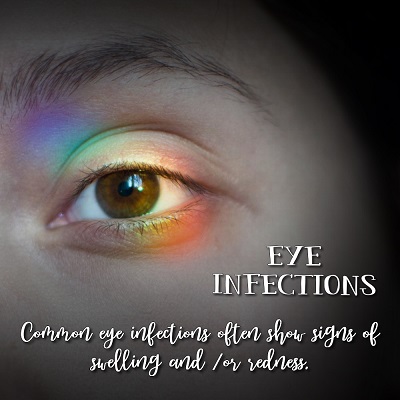 The eyes are complex organs with a direct line to the brain. Their job is incredibly important, and all the many working parts of an eye turn reflected light into the images we see.
The eyes are complex organs with a direct line to the brain. Their job is incredibly important, and all the many working parts of an eye turn reflected light into the images we see.
We’ve got to make it through our entire lifetime with just the two of them. Therefore, eye health should be a top priority if we want our eyes to last as long as possible.
There are several eye diseases we really can’t do much about and are a natural part of aging. Some of us will be affected, and others not so much. Overall health history is a big factor regarding eye disease later in life.
However, during the rest of our lifetime though, we are probably going to be challenged by an eye infection of one type or another. Arm yourself with the knowledge regarding common eye infections, what to look out for and how to treat them.
Sources of Eye Infections
You’ve probably already heard of bacterial and viral eye infections, but those aren’t the end all, be all, of the story. Allergies are a huge perpetrator of eye symptoms and infections. Eye infections can also stem from fungal sources, though more rare than bacterial or viral.
4 Common Eye Infections
If you take a look at the four common eye infections we list below, nearly all of them has the suffix “-itis” which basically describes an inflammatory response to something else. Therefore, with each one of these common eye infections you should expect to see some swelling and/or redness. This is how our body tells us something is wrong and we should probably take a closer look.
Other typical eye infection symptoms which should trigger further investigation, are pain, itching, increased tearing and tinted eye discharge. If you are experiencing any or all of these symptoms, please seek the advice of an eye care professional sooner rather than later.
1 – Conjunctivitis
More commonly referred to as “pink eye”, conjunctivitis is an inflammation of the outermost membrane surrounding your eyeball. The resultant appearance is a pink or red area on the whites of your eyes.
Allergic conjunctivitis is usually treated with over-the-counter antihistamines. If the origin is bacterial or fungal it is extremely contagious.
Bacterial conjunctivitis is treated with an antibiotic, usually in the form of an eyedrop, to kill the bacteria.
Fungal conjunctivitis just has to run its course, typically 7 to 10 days. Applying a clean, warm cloth several times a day to help with the discomfort is recommended, as well as frequent hand-washing.
2 – Keratitis
When the cornea is infected it’s called keratitis. The cornea is a clear, dome-shaped outer layer covering the iris and pupil. The biggest risk factors for developing keratitis are if your immune system is compromised, you use corticosteroid eyedrops for another condition, eye injury, and if you wear contact lenses.
The source of keratitis can be bacterial, viral, fungal, traumatic, or even parasitic though rare. Antibacterial or antiviral eyedrops are the usual course of treatment depending on which type of keratitis is to blame.
3 – Stye
The medical term is hordeolum, but ‘stye’ is much easier to remember and say. It’s similar to a pimple in appearance and usually occurs on the eyelid near the lashes. A stye is formed when an oil duct gets clogged or an eyelash follicle gets infected. Most styes will heal on their own in about a week and warm compresses several times a day can help alleviate the pain.
A chalazion is similar to a stye but it usually forms farther from the edge of the eyelid than a stye and they don’t typically turn red and painful. The majority of the time they will go away on their own. As with a pimple, doctors recommend to refrain from trying to “pop” the stye. You could inadvertently make the infection worse.
Treatment options for resistant styes are antibiotic ointments, steroid injections or surgical removal.
4 – Blepharitis
Inflammation of the whole eyelid is called blepharitis. It could be the top, bottom, or both, and it is caused by clogged oil glands. It feels as though something is stuck in your eye and you’ll notice increased tearing and probably some crusting on your eyelashes and in the corners of your eye.
You are at higher risk for blepharitis if you have dandruff, an allergic reaction to face products (make-up, creams, etc), lice or mites on your eyelashes or if you have a weakened immune system due to another illness.
Again, treatments are similar to most of the above approaches. A warm, wet compress, as well as corticosteroid eyedrops, will help control the swelling, redness and pain. Additionally, antibiotics might be a recommended course of treatment and artificial tears could help lubricate your eyes.
Preventive Measures
You can’t prevent every eye infection, but the following tips will definitely help:
- Wash your hands frequently
- Try to keep from rubbing or “scratching” your eyes if they are irritated
- Don’t share eye products
- Use proper care of contact lenses and don’t wear them for longer than they are designed
- Keep up with personal hygiene
- Wash sheets, pillowcases, towels and face cloths regularly
- Toss anything that’s been in contact with an infected eye.
Bottom line, don’t mess around when it comes to your eyes. If you think you might have an eye infection, go ahead and make that eye doctor appointment just to be on the safe side. Seeking treatment quickly greatly reduces your risk of severe complications.






